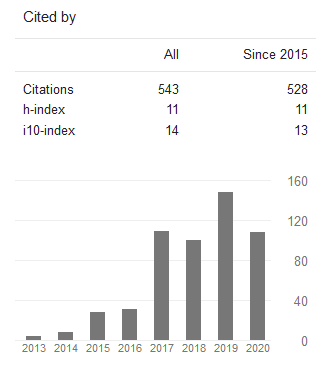Dekripsi Algoritma Rivest-Shamir-Adleman Dengan Komputasi Paralel Menggunakan Message Parsing Interface
DOI:
https://doi.org/10.24002/jbi.v8i1.1076Abstract
Abstract.
Rivest-Shamir-Adleman algorithm is a cryptographic algorithm that is difficult to be dismantled. This is due to the difficulty of factoring large numbers modulus n into prime factors (p and q). The process of modulus factoring requires a very long time if solved by serial computation. Brute Force Attack method is used to find large prime numbers p and q with parallel computation. Applications for the factorization of prime numbers p and q are developed using Visual C ++ and Message Passing Interface, while the decryption process developed with Java. The results show a parallel computing process faster than a serial for factoring very large numbers n, and very slow if the n is too small.
Keywords: Rivest-Shamir-Adleman Algorithm, Brute Force Attack, Message Passing Interface.
Abstrak.
Algoritma Rivest-Shamir-Adleman merupakan salah satu algoritma kriptografi yang sukar untuk dibongkar. Hal ini dikarenakan sulitnya memfaktorkan bilangan modulus n yang besar menjadi faktor-faktor prima (nilai p dan q). Proses untuk faktorisasi modulus n membutuhkan waktu yang sangat lama apabila diselesaikan dengan komputasi serial. Penelitian ini menggunakan metode Brute Force Attack untuk menemukan bilangan prima p dan q yang sangat besar yang dikerjakan secara paralel. Aplikasi untuk faktorisasi bilangan prima p dan q dikembangkan menggunakan Visual C++ memanfaatkan Message Passing Interface, sedangkan aplikasi proses dekripsi dengan Java. Hasil ujicoba menunjukkan proses komputasi paralel lebih cepat dibandingkan secara serial untuk memfaktorkan bilangan n yang sangat besar, dan menjadi sangat lambat apabila bilangan n terlalu kecil.
Kata kunci: Algoritma Rivest-Shamir-Adleman, Brute Force Attack, Message Passing Interface.
References
Ali, Z., & Ahmad, A. 2016. Implementation of Parallel Algorithm for LUC Cryptosystems Based On Addition Chain by a Message Passing Interface. Journal of Theoretical and Applied Information Technology. Vol.92 No.1, pp.190-192.
Asaduzzaman, A., Asmatulu, R., & Rahman, M. 2014. Teaching Parallel Programming for Time-Efficient Computer Applications. International Journal of Computer Applications, Vol.90 No.7, pp.18-22.
Gropp, W., Lusk, E., Doss, N., & Skjellum, A. 1996. A high-performance, portable implementation of the MPI message passing interface standard. Parallel Computing Journal, Vol.22, pp.789–828.
He, D., Khan, M. K., & Wu, S. 2014. On the Security of a RSA-based Certificateless Signature Scheme. International Journal of Network Security, Vol.16, pp.78-80.
Khalifa, Osama. 2011. The Performance Of Cryptographic Algorithms In The Age Of Parallel Computing. [Tesis]. School of Mathematical and Computer Science, Heriot Watt University; Hal. 38-40.
Li, D., Ji, X., & Wang, Q. 2013. An Efficient Parallel Computing Method for the Processing of Large Sensed Data. AUTOMATIKA Journal. Vol. 54, pp.471–482.
Mahajan, S., & Singh, M. 2014. Analysis of RSA Algorithm Using GPU Programming. International Journal of Network Security & Its Applications (IJNSA), Vol.6, pp.13-27.
Munir, Rinaldi. 2006. Kriptografi. Bandung: Penerbit Informatika.
Rahmawati, W.I. 2014. Analisis Perolehan Kecepatan Operasi Enkripsi/Dekripsi RSA. Seminar Nasional Aplikasi Sains & Teknologi (SNAST 2014). Yogyakarta. 15 November 2014. Hal 421-424.
Roy, A., & Karforma, S. A. 2014. Study on Implementation of Security in E-Governance using Cryptography. International Journal of Advanced Research in Computer Science and Software Engineering, Vol.4 No.4, pp.652-659.
Wulansari, D., Alamsyah, Setyawan, F.A., & Susanto, H. 2016. Mengukur Kecepatan Enkripsi dan Dekripsi Algoritma RSA pada Pengembangan Sistem Informasi Text Security. Seminar Nasional Ilmu Komputer (SNIK 2016). Semarang. 10 Oktober 2016. Hal 85-91.
Zhong, Y. 2013. Secure Digital Certificate Design Based on the RSA Algorithm. Journal of Digital Information Management, Vol.11 No.6, pp.423-429.
Downloads
Published
Issue
Section
License
Copyright of this journal is assigned to Jurnal Buana Informatika as the journal publisher by the knowledge of author, whilst the moral right of the publication belongs to author. Every printed and electronic publications are open access for educational purposes, research, and library. The editorial board is not responsible for copyright violation to the other than them aims mentioned before. The reproduction of any part of this journal (printed or online) will be allowed only with a written permission from Jurnal Buana Informatika.
This work is licensed under a Creative Commons Attribution-ShareAlike 4.0 International License.









